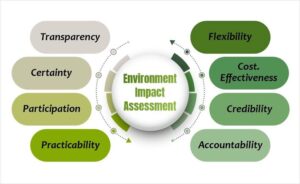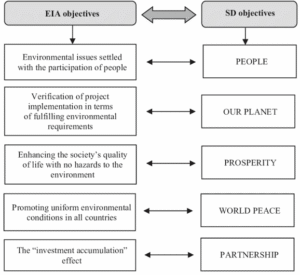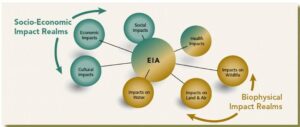Back to: Environmental Biology 300 Level
Welcome to class!
Hello, brilliant scholar! Have you ever seen a new factory, highway, or housing estate being built and wondered what effects it might have on the surrounding environment? Will it pollute the air or water? Will it destroy farmlands or affect wildlife? These are the very questions Environmental Impact Assessment (EIA) helps us answer. Today, you’ll understand how EIA works, why it matters, and how it’s shaping development in Nigeria.
Environmental Impact Assessment (EIA)
What is Environmental Impact Assessment (EIA)
Environmental Impact Assessment is a formal process used to predict how a proposed project—like constructing a dam, mining site, or highway—might affect the environment before it begins. The goal is to prevent or minimise damage to nature and communities by carefully examining potential environmental risks and suggesting solutions before any major decisions are made.

In Nigeria, the EIA process is enforced by the Federal Ministry of Environment and governed by the Environmental Impact Assessment Act of 1992. This law ensures that no major project starts without first being reviewed for its environmental consequences.
Why EIA is Important
It helps protect natural ecosystems by identifying harmful effects early.
It promotes sustainable development by ensuring that economic growth doesn’t destroy the environment.
It gives communities a voice in projects that may affect their lives.
It prevents costly mistakes and long-term damage by proposing alternatives.
For example, before an oil company starts drilling in the Niger Delta, an EIA must assess how the project might affect farmlands, rivers, and people’s livelihoods. If the risks are too high, the project might be stopped or changed to reduce harm.

Steps in the EIA Process
Screening: Determines whether a project requires a full EIA.
Scoping: Identifies what environmental factors need to be studied (e.g. air, soil, water, noise, wildlife).
Impact Analysis: Studies the potential effects of the project on the environment.
Mitigation Measures: Suggests ways to reduce or eliminate negative impacts.
Public Participation: Communities and stakeholders give feedback.
EIA Report Submission: A full report is submitted to regulatory bodies.
Review and Decision: Authorities approve, reject, or request modifications to the project.
Challenges of EIA in Nigeria

EIA is a powerful tool, but it faces issues like political interference, corruption, lack of public awareness, poor monitoring, and low enforcement. In some areas, projects continue without proper assessments, leading to pollution, displacement, or ecosystem destruction.
Summary
- Environmental Impact Assessment (EIA) predicts and evaluates how projects may affect the environment.
- It is legally required for major projects in Nigeria under the 1992 EIA Act.
- EIA promotes sustainable development by preventing or reducing environmental harm.
- The process includes screening, scoping, analysis, mitigation, public input, reporting, and decision-making.
- Challenges in Nigeria include weak enforcement, limited awareness, and lack of transparency.
Evaluation
- What is Environmental Impact Assessment (EIA)?
- State three reasons why EIA is important.
- List four steps involved in the EIA process.
- Mention two major challenges EIA faces in Nigeria.
Fantastic work today! By understanding EIA, you’re stepping into the role of an environmental leader—one who thinks ahead, values nature, and helps build a greener, safer Nigeria. Keep going strong, and remember—Afrilearn is proud to grow with you on this journey!
